Overview
The article titled "7 Strategies for Effective Transmission System Resilience Upgrades" primarily focuses on outlining essential strategies that significantly enhance the resilience of transmission systems. It discusses various approaches, such as:
- Stakeholder collaboration
- Data-driven decision-making
- The integration of renewable energy
These strategies are emphasized as collectively improving reliability and equipping power networks to withstand disruptions caused by severe weather and other challenges.
Introduction
In the rapidly evolving landscape of energy and infrastructure, the significance of robust transmission systems is undeniable. Communities are increasingly confronted with the dual challenges of climate change and surging energy demands, underscoring the necessity for innovative solutions.
From the integration of renewable energy sources to the application of AI-powered technologies, the strategies for enhancing transmission resilience are both diverse and critical. This article explores the multifaceted approaches essential for modernizing energy systems, highlighting the importance of:
- Stakeholder collaboration
- Regulatory compliance
- Community engagement
- Data-driven decision-making
By examining these vital components, we can better understand how to construct a sustainable and resilient energy future for rural America and beyond.
Harbinger Land | Comprehensive Solutions for Land Services in Energy and Infrastructure
Navigating the complexities of land services is crucial for energy and infrastructure initiatives, and Harbinger Land excels in this domain. Their comprehensive offerings, which include:
- Site and right-of-way acquisition
- Title research
- GIS mapping
- Efficient document imaging solutions
are designed to meet the multifaceted needs of their clients. By employing advanced technology—such as AI-driven title research software and closely integrated GIS modeling services—Harbinger Land significantly enhances operational efficiency and client satisfaction. This positions them as an essential ally for natural gas firms, solar developers, and municipalities.
The experienced team at Harbinger Land is adept at swiftly mobilizing large groups to address varied project requirements. They ensure that services are delivered promptly and accurately, tailored to the unique needs of each client. Additionally, Harbinger Land digitizes property data by deploying imaging agents to courthouses or acquiring documents through records requests, facilitating efficient title research and leasing.
As the land acquisition market evolves in 2025, it is vital to embrace data-driven insights for anticipating shifts and optimizing strategies. This evolution further solidifies Harbinger Land's role as a leader in the field, as they continue to leverage data and technology to enhance their services. In a landscape where challenges abound, partnering with Harbinger Land can provide the expertise and resources necessary to navigate the complexities of land acquisition effectively.
Grid Infrastructure Enhancement: Key to Resilience in Rural America
Enhancing grid infrastructure is imperative for bolstering resilience in rural America, where power networks encounter distinct challenges. Improved infrastructure not only ensures a reliable power supply but also mitigates the adverse effects of severe weather events, which increasingly threaten power systems. Recent estimates indicate that the cost of burying power lines can reach approximately $1 million per mile, underscoring the significant financial investment required for modernization initiatives critical to rural power resilience.
Investments in transmission system resilience upgrades, which encompass upgrading transmission lines, substations, and distribution networks, are vital for providing rural communities with stable and resilient power sources. For instance, regions like Michigan and Oregon are embracing innovative infrastructure solutions, such as underwater inspections and power recovery from water pipelines. These initiatives enhance efficiency and directly contribute to the transmission system resilience upgrades by ensuring power systems' ability to withstand disruptions.
Moreover, the integration of Power as a Service (PaaS) models can substantially bolster grid assets by incorporating renewable energy sources and advanced software, further reinforcing the infrastructure. As noted by Spencer Pederson, Senior Vice President of Public Affairs for the National Electrical Manufacturers Association, "All of these elements have a place in NEMA’s vision for a more electrified and connected economy." This perspective highlights the importance of comprehensive enhancements in improving reliability and preparing rural areas to tackle the challenges posed by severe weather and other disturbances.
The commitment to enhancing grid infrastructure not only promotes reliability but also fosters a more resilient power future for rural America. Directors of Land Acquisition should view these strategies and investments as essential measures for achieving a robust and sustainable resource landscape.
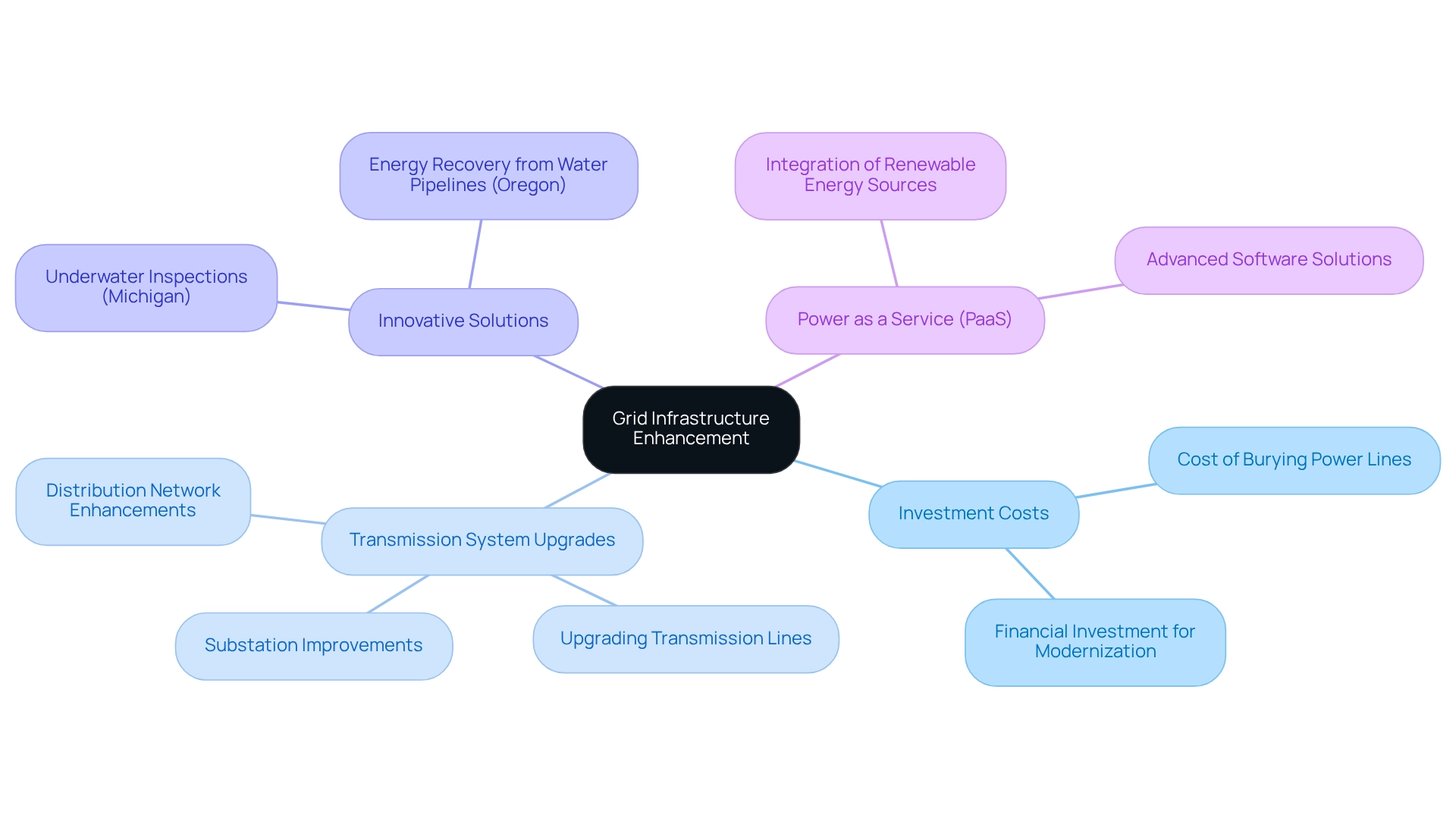
AI-Powered Solutions: Transforming Transmission System Resilience
AI-driven solutions are fundamentally transforming the operation and supporting transmission system resilience upgrades in transmission networks. By harnessing machine learning algorithms and predictive analytics, utility companies can proactively identify potential failures and optimize maintenance schedules. This proactive approach not only minimizes downtime but also significantly enhances grid reliability with transmission system resilience upgrades.
Consider how AI analyzes extensive datasets from diverse sources, empowering operators to make informed decisions that bolster resilience. A notable case study illustrates how AI-driven smart grids effectively curtail surplus power generation, thereby reducing carbon emissions and advancing sustainability initiatives.
As the computational capacity required for AI continues to double approximately every 100 days, the potential for these technologies to enhance power transmission systems grows increasingly significant. The International Energy Agency (IEA) underscores the importance of balancing AI's power demands with its innovative solutions to climate challenges, suggesting that the benefits of these advancements may outweigh their costs.
Ultimately, the integration of AI and machine learning in energy transmission system resilience upgrades not only boosts operational efficiency but also aligns with broader sustainability objectives.

Stakeholder Collaboration: Essential for Effective Transmission Upgrades
Collaboration among stakeholders—including utility companies, government agencies, and community organizations—is essential for the successful execution of transmission system resilience upgrades. Engaging stakeholders early in the planning phase not only helps identify potential challenges but also aligns diverse interests, facilitating a smoother execution process. Regular communication and transparency are vital for building trust, which enables effective implementation and ultimately leads to more resilient energy systems.
Notably, studies show that 39% of social media users expect quick responses, based on a sample of 144 respondents. This statistic highlights the necessity for rapid engagement strategies. Effective community engagement strategies have proven that involving stakeholders in high-value initiatives enhances their contributions and commitment, as illustrated by the case study 'Waiting to be Shaped and Deployed: Lower Voice and Value.' This case study underscores the potential for growth through strategic engagement, resulting in improved investment strategies and clearer plans.
By prioritizing stakeholder collaboration, power projects can achieve greater success and implement transmission system resilience upgrades. It is imperative that the energy sector recognizes the complexities of stakeholder engagement and actively seeks to implement these strategies for enhanced outcomes.
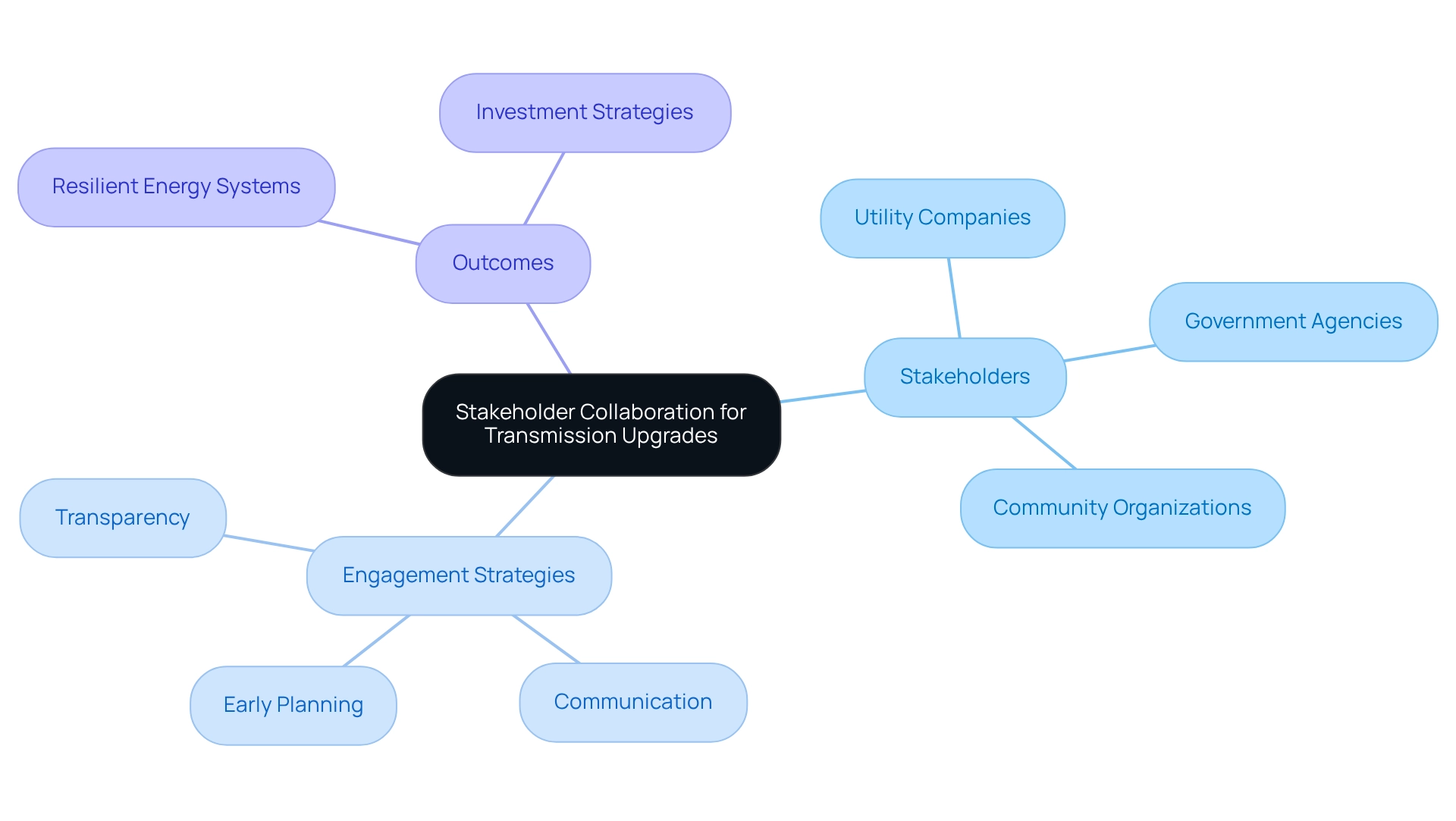
Regulatory Compliance: Navigating Legal Requirements for Upgrades
Navigating the intricate regulatory landscape is crucial for the successful implementation of transmission system resilience upgrades in the power sector. Adherence to federal, state, and local regulations not only ensures lawful execution but also enhances operational efficiency for firms within this industry. Given the unique challenges they encounter, it is imperative for these firms to remain vigilant about evolving regulations and actively engage with regulatory bodies throughout the upgrade process. This proactive stance is vital, as 40% of supply chain professionals identify risk management and supply chain resilience as their primary concerns—a statistic that resonates profoundly within the sector due to its regulatory complexities.
By promoting ongoing oversight systems and establishing clear reporting protocols designed for resource initiatives, organizations can build confidence among stakeholders and mitigate risks associated with regulatory adherence. A notable case study illustrates this: an Internet infrastructure services provider implemented advanced compliance management tools, which led to reduced regulatory risks and enhanced stakeholder confidence. Such strategic approaches are essential for averting potential legal issues that could otherwise delay timelines, ensuring that transmission system resilience upgrades are completed on schedule and within regulatory frameworks.
To further bolster compliance, businesses in the sector should consider instituting regular training sessions for their teams on the latest regulatory changes and best practices. This ensures that all stakeholders are informed and adequately prepared to navigate the complexities of the regulatory landscape.
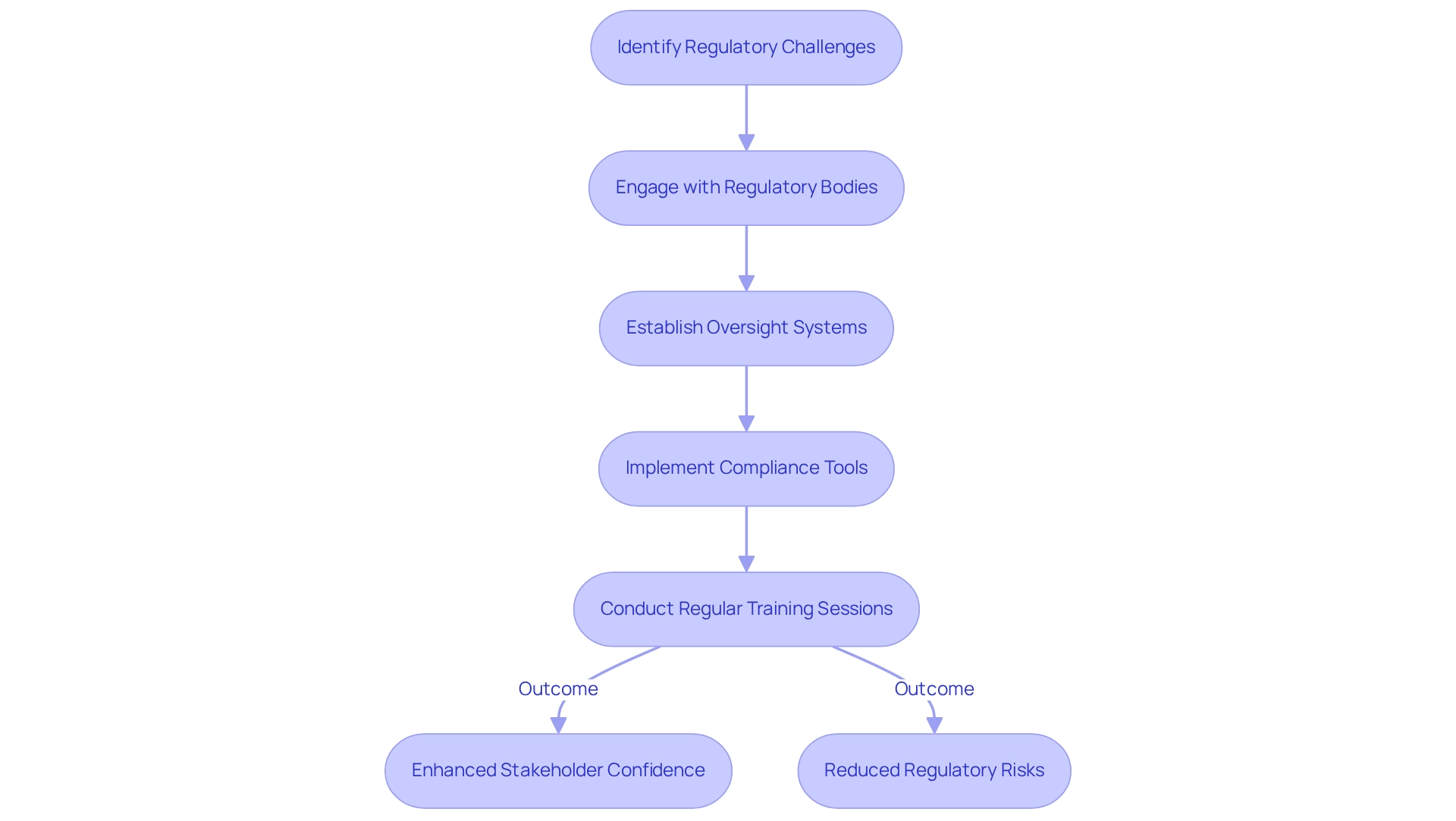
Community Engagement: Building Support for Transmission Upgrades
Community engagement is paramount for the success of transmission system resilience upgrades. By actively involving local residents and stakeholders in the planning process, energy companies can effectively address concerns and cultivate support for their initiatives. Statistics indicate that initiatives lacking community involvement typically have an average lifespan of just eight years, underscoring the critical need for proactive engagement.
Effective communication strategies, such as public meetings and informational campaigns, are instrumental in educating the community about the advantages of transmission system resilience upgrades. Such initiatives foster a sense of ownership and collaboration, significantly enhancing execution.
Furthermore, participatory governance is vital for integrating social, environmental, and economic outcomes, ensuring that initiatives resonate with local priorities and values. For instance, the case study on Participatory Action Research for Community Development demonstrates how involving community members in every phase of the research process fosters ownership and sustainability, yielding robust evidence of success.
By prioritizing community involvement, utility firms can not only mitigate potential delays and cancellations but also lay the groundwork for sustainable project success with transmission system resilience upgrades.

Renewable Energy Integration: Strengthening Rural Transmission Systems
Incorporating renewable power sources into rural transmission systems is essential for transmission system resilience upgrades and encouraging sustainability. The global push for clean power necessitates the evolution of existing infrastructure to support innovative technologies like solar and wind. This shift diversifies power portfolios and reduces reliance on fossil fuels, promoting a more resilient and environmentally sustainable power framework.
Recent statistics indicate that commitments across Nationally Determined Contributions (NDCs) have reached approximately 1,300 GW, underscoring the urgency for operators to reevaluate their planning and operational strategies to facilitate this transition. Furthermore, from 2023 to 2024, solar photovoltaic (PV) capacity in advanced stages increased by nearly 15%, reflecting a broader trend of global renewable resource adoption.
The 2023 United Nations Climate Change Conference (COP 28) highlighted the necessity of global collaboration on sustainable resources, with governments pledging to triple renewable power capacity and double efficiency enhancements by 2030. This commitment presents a significant opportunity for nations to enhance their renewable resource targets and align their policies with global climate objectives.
Successful adaptations of infrastructure for solar and wind power have already been observed in various regions, showcasing the potential for improved grid resilience. Experts emphasize that integrating these renewable resources into rural transmission networks, through transmission system resilience upgrades, enhances power security and stimulates local economies by generating jobs and fostering innovation. As the U.S. Energy Information Administration notes, "We forecast consumption growth of crude oil and other liquid fuels will slow over the next two years, driven by a slowdown in economic growth, particularly in Asia." This observation underscores the critical importance of transitioning to renewable sources. As the energy landscape evolves, focusing on renewable energy integration will be vital for achieving a sustainable and resilient future.
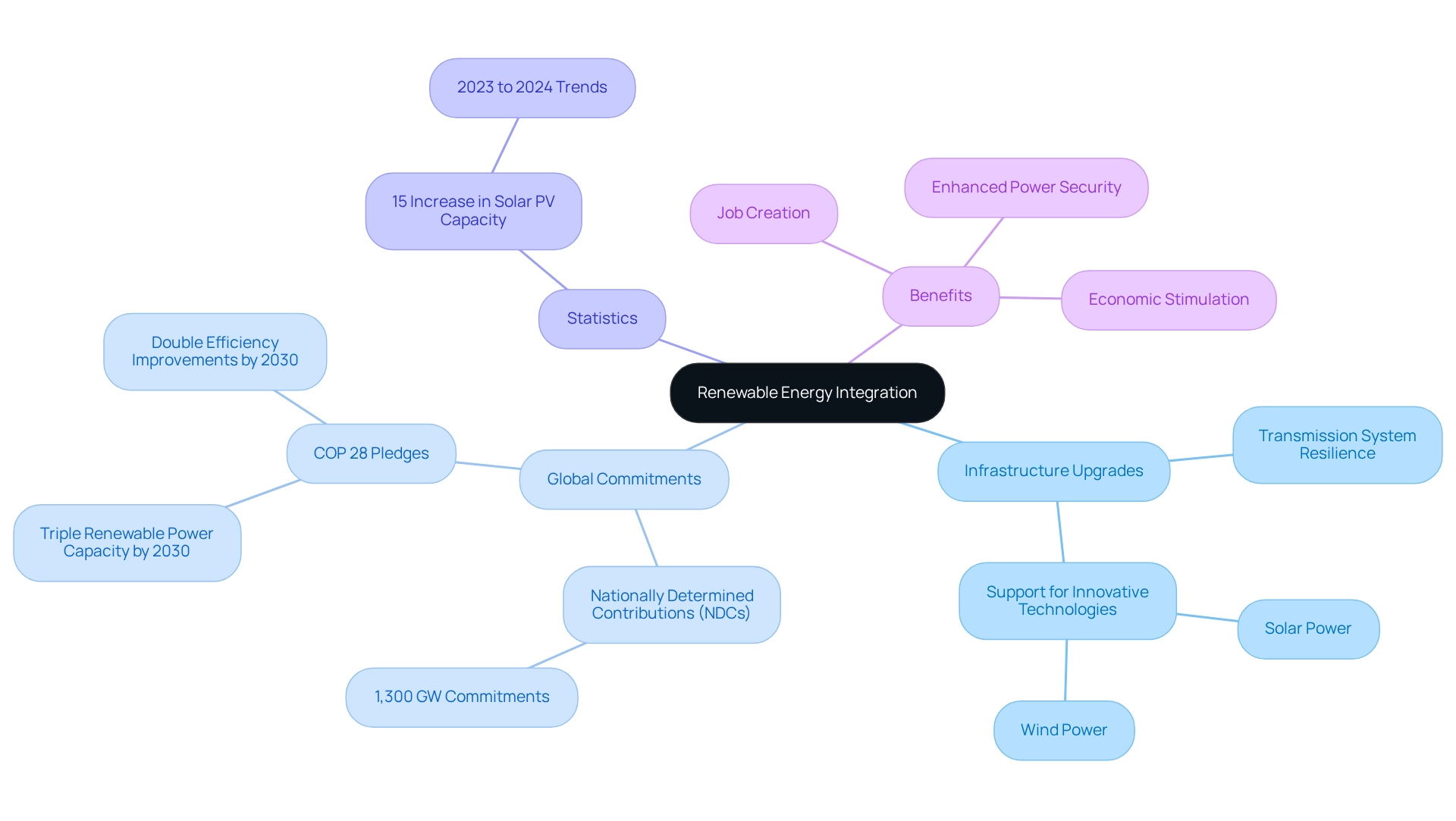
Funding and Investment: Fueling Transmission System Resilience
Securing adequate funding and investment is imperative for the successful implementation of transmission system resilience upgrades. Various funding sources, such as federal grants, state programs, and private investments, can be strategically leveraged to support these initiatives. Energy companies must craft comprehensive financial strategies that clearly outline the costs and benefits of upgrades, ensuring that projects are both financially viable and aligned with long-term resilience goals.
As Ali Zaidi, White House National Climate Advisor, emphasized, "As we develop the nation’s power grid to keep up with historic manufacturing and clean-source growth, we are doing so by utilizing innovative technologies to reduce costs, create hundreds of thousands of well-paying jobs, and address the climate crisis." This insight underscores the critical role of innovative technologies in funding strategies.
Moreover, staying informed about the IEA Government Energy Spending Tracker can provide valuable insights into governmental spending policies related to energy resources. To effectively navigate the complexities of funding and implement transmission system resilience upgrades for their networks, energy companies should proactively seek out and apply for available federal grants and state programs. This approach ensures they are well-positioned to capitalize on these essential financial resources.
Maintenance and Monitoring: Ensuring Long-Term Resilience of Transmission Systems
Continuous upkeep and observation are essential for ensuring the long-term durability of transmission networks. Implementing predictive maintenance strategies, utilizing advanced monitoring technologies, and conducting regular inspections can help identify potential issues before they escalate. The FNET/GridEye network, developed in response to the extensive blackout in 2003 that affected 50 million individuals, exemplifies how real-time monitoring can enhance grid reliability. This framework correlates real-time measurements with geographical information, providing operators with intuitive visualization tools that improve their understanding of grid performance during disturbances. Such innovations not only reduce overall costs but also bolster cybersecurity efforts, underscoring the critical role of technology in modern energy infrastructure. The research team for FNET/GridEye includes esteemed organizations such as UT, Tennessee Valley Authority, ABB, and Dominion Resources, which adds credibility to its development.
Regular inspections and the integration of digital tools can significantly enhance reliability. A study from the World Economic Forum projected that digitalization in the electricity sector could generate $1.3 trillion in value between 2016 and 2025, highlighting how effective maintenance strategies contribute to realizing this value. Exelon Corporation has demonstrated this by creating a detailed integration framework that enabled them to incorporate predictive maintenance features atop existing operational technology without replacing essential control infrastructures. By prioritizing maintenance, utility providers can implement transmission system resilience upgrades to mitigate the risk of outages, contributing to a more resilient grid and ultimately ensuring a stable supply for consumers and businesses alike.
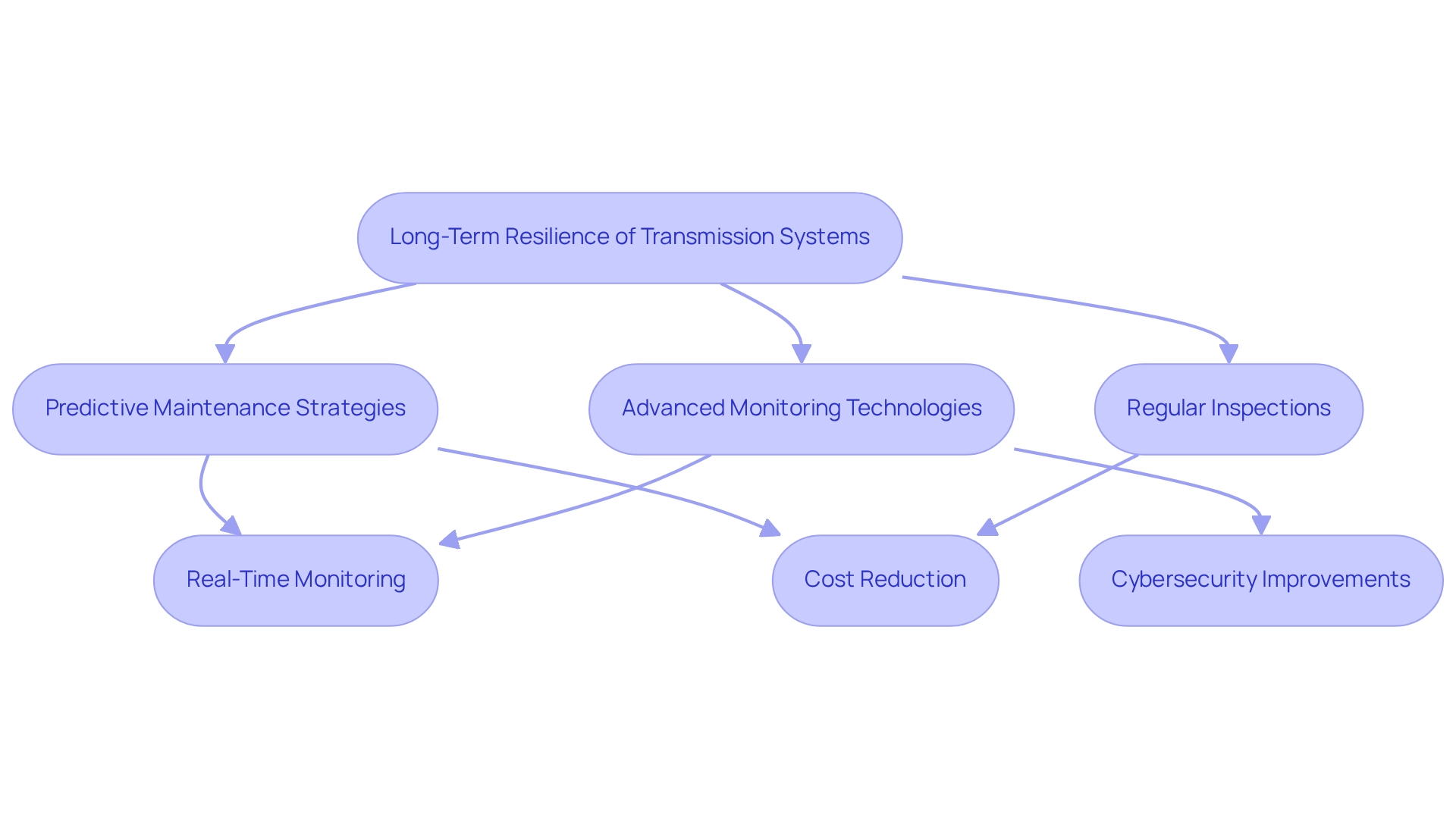
Data-Driven Decision Making: Optimizing Transmission System Upgrades
Data-driven decision-making is fundamentally transforming the planning and execution of transmission system resilience upgrades. By leveraging advanced analytics and modeling tools, firms can refine their upgrade strategies through real-time data and predictive insights. This methodology significantly enhances decision-making related to resource allocation and project timelines, while also fortifying risk management practices.
Consider the case study titled "Consumer Behavior and Grid Management"; it illustrates how understanding consumer behavior via data analysis empowers companies to identify peak load times, a crucial factor for balancing power distribution during high-demand periods. Additionally, real-time analytics facilitate adjustments based on immediate evaluations of grid performance, ensuring that transmission system resilience upgrades help networks remain resilient and responsive.
As the utilities sector increasingly adopts innovations such as ANOVA, the potential for improved energy analytics continues to expand, paving the way for more effective and sustainable transmission systems.

Conclusion
The modernization of energy transmission systems represents a critical undertaking, underpinned by several essential components:
- Stakeholder collaboration
- Regulatory compliance
- Community engagement
- Data-driven decision-making
Each of these elements is crucial for enabling energy systems to adapt to the challenges posed by climate change and escalating energy demands.
Investing in grid infrastructure enhancements not only strengthens resilience in rural America but also equips communities to better endure extreme weather events. The integration of AI-powered technologies revolutionizes these systems, facilitating smarter maintenance and operational strategies that enhance reliability and sustainability. By actively involving stakeholders and local communities in the planning process, energy companies can foster support and address concerns, ultimately resulting in more successful project outcomes.
Furthermore, the commitment to incorporating renewable energy sources is vital for establishing a sustainable energy future. As the global landscape transitions towards cleaner energy solutions, the demand for innovative funding and investment strategies becomes critical. By leveraging available financial resources and prioritizing ongoing maintenance and monitoring, energy companies can guarantee the longevity and resilience of their transmission systems.
In conclusion, constructing a robust and resilient energy future necessitates a holistic approach that embraces collaboration, technology, and community involvement. By concentrating on these strategies, stakeholders can forge a more sustainable and efficient energy landscape that benefits rural America and beyond. The path forward lies in acknowledging the interconnectedness of these elements and dedicating ourselves to a collective vision for an electrified and resilient economy.
Frequently Asked Questions
What services does Harbinger Land provide for energy and infrastructure projects?
Harbinger Land offers comprehensive services including site and right-of-way acquisition, title research, GIS mapping, and efficient document imaging solutions.
How does Harbinger Land enhance operational efficiency?
Harbinger Land employs advanced technology such as AI-driven title research software and integrated GIS modeling services to significantly enhance operational efficiency and client satisfaction.
Who are the primary clients of Harbinger Land?
The primary clients of Harbinger Land include natural gas firms, solar developers, and municipalities.
What approach does Harbinger Land take to project management?
The experienced team at Harbinger Land is skilled at swiftly mobilizing large groups to address various project requirements, ensuring services are delivered promptly and accurately.
How does Harbinger Land handle property data?
Harbinger Land digitizes property data by deploying imaging agents to courthouses or acquiring documents through records requests, facilitating efficient title research and leasing.
What is the significance of grid infrastructure enhancement in rural America?
Enhancing grid infrastructure is crucial for ensuring a reliable power supply and mitigating the adverse effects of severe weather events that threaten power systems in rural America.
What are some financial considerations for grid modernization initiatives?
The cost of burying power lines can reach approximately $1 million per mile, highlighting the significant financial investment required for modernization efforts.
What innovative solutions are being implemented to improve grid resilience?
Regions like Michigan and Oregon are adopting innovative infrastructure solutions such as underwater inspections and power recovery from water pipelines to enhance efficiency and resilience.
How can Power as a Service (PaaS) models contribute to grid enhancement?
PaaS models can strengthen grid assets by incorporating renewable energy sources and advanced software, thereby reinforcing the infrastructure.
How are AI-driven solutions impacting transmission system resilience?
AI-driven solutions are transforming transmission networks by using machine learning algorithms and predictive analytics to identify potential failures and optimize maintenance schedules, enhancing grid reliability.
What is the future outlook for AI in energy transmission systems?
As computational capacity for AI continues to grow, its potential to enhance power transmission systems and contribute to sustainability initiatives is expected to increase significantly.
List of Sources
- Harbinger Land | Comprehensive Solutions for Land Services in Energy and Infrastructure
- 7 Stats Revealed: Poisson Regression in Real Estate Trends (https://numberanalytics.com/blog/poisson-regression-real-estate-trends)
- Land Values Insider (https://landvalues.acres.com/all)
- 40+ Housing and Real Estate Statistics for 2025 (https://learn.g2.com/real-estate-statistics)
- Grid Infrastructure Enhancement: Key to Resilience in Rural America
- New Infrastructure Act Funding Release: DOE Allocates $3.5B toward Grid Resilience, Microgrids Nationwide (https://microgridknowledge.com/government/article/33013434/new-infrastructure-act-funding-release-35b-toward-grid-resilience-microgrids-nationwide)
- Energy (https://infrastructurereportcard.org/cat-item/energy-infrastructure)
- AI-Powered Solutions: Transforming Transmission System Resilience
- How artificial intelligence can transform transmission and distribution (https://renewableenergyworld.com/news/how-artificial-intelligence-can-transform-transmission-and-distribution)
- AI-Powered Smart Grids: How They Are Revolutionizing Energy Distribution (Latest Stats) (https://patentpc.com/blog/ai-powered-smart-grids-how-they-are-revolutionizing-energy-distribution-latest-stats)
- What’s the impact of artificial intelligence on energy demand? (https://sustainabilitybynumbers.com/p/ai-energy-demand)
- Stakeholder Collaboration: Essential for Effective Transmission Upgrades
- What Statistics Indicate The Impact of Stakeholder Engagement? → Question (https://sustainability-directory.com/question/what-statistics-indicate-the-impact-of-stakeholder-engagement)
- stratfordjournals.com (https://stratfordjournals.com/journals/index.php/journal-of-entrepreneurship-proj/article/view/1680)
- Stakeholder Engagement Effectiveness Statistics (https://zoetalentsolutions.com/stakeholder-engagement-effectiveness)
- Regulatory Compliance: Navigating Legal Requirements for Upgrades
- 110 Compliance Statistics to Know for 2025 (https://secureframe.com/blog/compliance-statistics)
- Best Practices for Regulatory Compliance for Utilities: Proven Strategies for Success (https://blog.harbingerland.com/best-practices-for-regulatory-compliance-for-utilities-proven-strategies-for-success)
- Community Engagement: Building Support for Transmission Upgrades
- What Statistics Indicate Community Involvement's Impact on Project Success? → Question (https://sustainability-directory.com/question/what-statistics-indicate-community-involvements-impact-on-project-success)
- Renewable Energy Companies Need Experienced Help with Community Engagement - MOWER (https://mower.com/news/renewable-energy-companies-need-experienced-help-with-community-engagement)
- Renewable Energy Integration: Strengthening Rural Transmission Systems
- Electricity – Renewables 2024 – Analysis - IEA (https://iea.org/reports/renewables-2024/electricity)
- Today in Energy - U.S. Energy Information Administration (EIA) (https://eia.gov/todayinenergy/detail.php?id=61242)
- RENEWABLE ENERGY IN ENERGY SUPPLY | Global Trends (https://ren21.net/gsr-2024/modules/energy_supply/01_global_trends)
- How grid operators can integrate the coming wave of renewable energy (https://mckinsey.com/industries/electric-power-and-natural-gas/our-insights/how-grid-operators-can-integrate-the-coming-wave-of-renewable-energy)
- Funding and Investment: Fueling Transmission System Resilience
- Government Energy Spending Tracker – Analysis - IEA (https://iea.org/reports/government-energy-spending-tracker-2)
- US Invests $2.2B Into Grid Upgrades for Climate Resilience (https://sustainablebrands.com/read/us-22b-grid-upgrades-climate-resilience)
- Maintenance and Monitoring: Ensuring Long-Term Resilience of Transmission Systems
- The Evolution of Maintenance Strategies in Power Transmission and Distribution: A Convergence of Traditional Electrical Engineering and AI (https://linkedin.com/pulse/evolution-maintenance-strategies-power-transmission-ai-mitsainas-hntyf)
- Eye on the Grid: System monitoring increases power grid reliability | ORNL (https://ornl.gov/research-highlight/eye-grid-system-monitoring-increases-power-grid-reliability)
- Modern Energy & Utilities with Smart Predictive Maintenance (https://numberanalytics.com/blog/modern-energy-utilities-smart-predictive-maintenance)
- Data-Driven Decision Making: Optimizing Transmission System Upgrades
- 8 Statistical Correlations Elevating Energy & Utility Performance in 2023 (https://numberanalytics.com/blog/8-statistical-energy-utility-performance-2023)
- The Role of Data Analytics in Optimizing Energy Management Software (https://moldstud.com/articles/p-the-role-of-data-analytics-in-optimizing-energy-management-software)
- 7 Surprising Stats: ANOVA's Role in Energy & Utilities (https://numberanalytics.com/blog/anova-energy-statistics-utilities)
- 51 Best Quotes on Data Science by Thought Leaders (https://datasciencedojo.com/blog/best-quotes-on-data-science)




